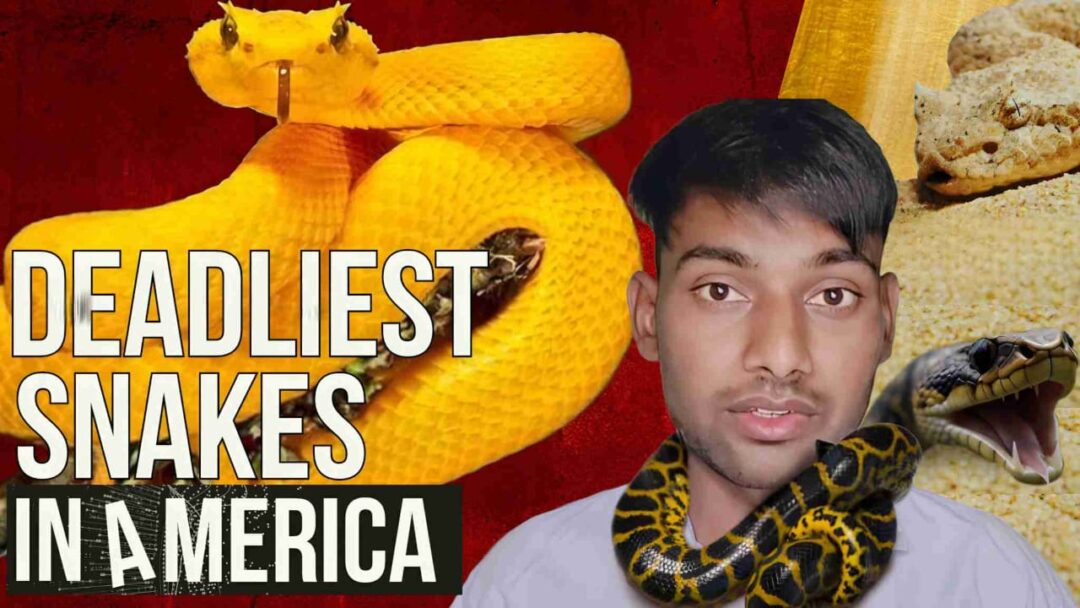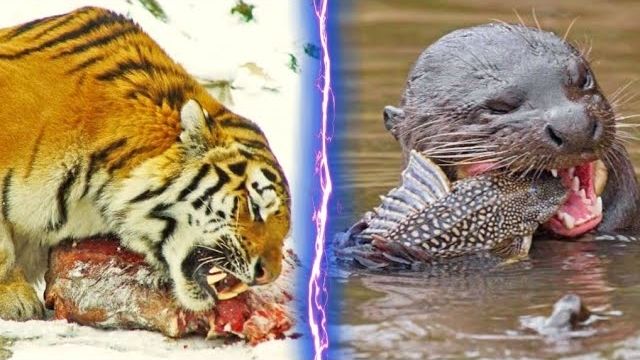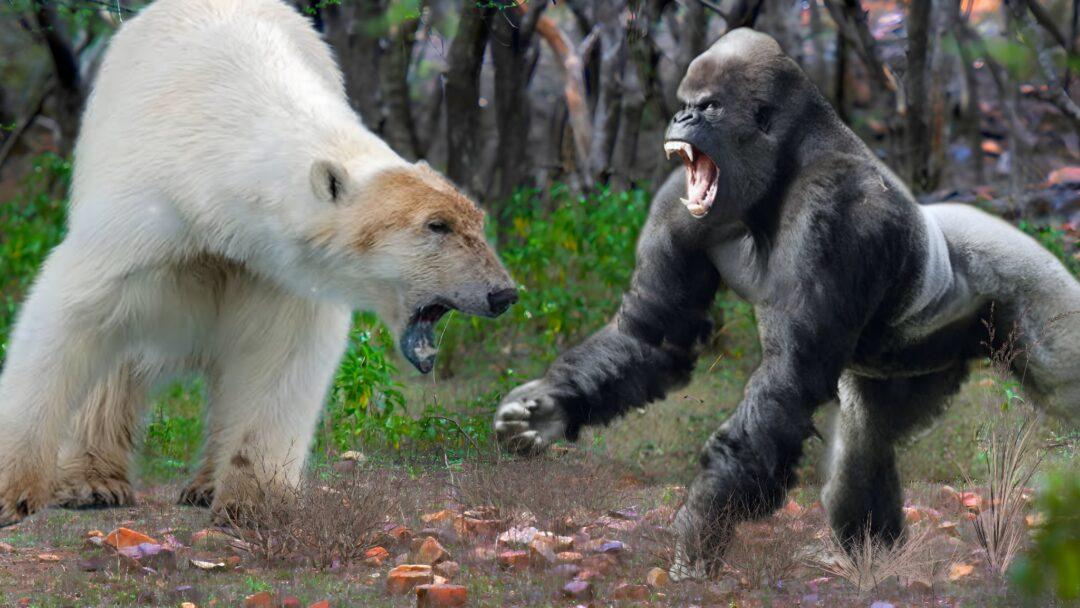Table of Contents

Introduction
In America, the world’s largest snake preys on the country’s largest rodents. For all of us, snakes are dangerous creatures. They bite over 5 million people every year. Some snakes have venom that is highly lethal, while others have aggressive behavior, and some snakes possess both of these characteristics. Some people believe that the Anaconda is America’s most deadly snake, but is this really true? We are going to talk about the top 10 deadliest snakes in America. Among them, which snake is the most lethal? What are your chances of surviving an encounter with it? We’ll tell you. So, stay tuned with Animal TV Hindi and enjoy the blog.
North, Central, and South America are home to millions of people, and together they are also home to hundreds of thousands of snakes. These include venomous snakes and snakes that can crush bones. Which snake should you be most afraid of, and which snake should you be most concerned about? Let’s find out.
10. Coral Snake
Here in America, there is another snake that you can easily recognize. Its name is the Coral Snake. It’s not very large, but its venom is highly deadly. Although when it bites the animal in front of it, it leaves only a small amount of venom. Thousands of people are preyed upon by this snake every year, and many lose their lives. This snake’s venom works differently from other snakes.
The prey doesn’t even realize when it has been bitten. During the bite, there is a pain like an ant bite, and then, a few hours later, due to a sudden heart attack or an imbalance in the brain’s equilibrium, death is certain. But if you know you’ve been bitten by this snake, you can go to the hospital immediately to survive. That’s why this snake has found a place in our list at number 10.
9. Red-Tailed Boa
While the Anaconda roams on the ground below, there’s another powerful snake that lives in the trees. Although it doesn’t have venom, it’s no less than anyone in capturing prey. Weighing around 30 kilos, the Red-Tailed Boa spends most of its time in the trees but can prey on anything. Many people keep this snake as a pet in America. At first, it’s quite small, but as it grows, the length of this snake can reach up to about 10 feet.
Having a 10-foot pet snake in your house, especially with your children, is not safe in any way. This snake may look innocent, but it has already made more than 20 children its prey in America. That’s why Red-Tailed Boa is also counted among America’s most dangerous snakes.
8. Anaconda
The Amazon is the world’s largest jungle, and the Amazon River is the world’s largest river by water volume. It’s home to the world’s largest snake, the Anaconda, measuring around 30 feet in length and weighing over 400 kilograms. This snake, which is the most powerful in the Amazon jungle, has more than 100 sharp, backward-facing teeth in its mouth.
You can’t even begin to imagine what this formidable creature is capable of. Anacondas spend most of their time submerged in water, holding their breath for nearly 10 minutes. If you happen to be in an area where an Anaconda resides, you won’t even notice it approaching you. In such a situation with a heavy and powerful snake right under your feet, what would you do?
In my opinion, there’s not much you can do. Their sudden attack technique, with an unmatched strength to constrict, can put you into a deep sleep within minutes. Over 300 million people live around the Amazon River, but the Anaconda pays more attention to its natural prey than humans. It’s not surprising that the Anaconda is one of the most dangerous snakes in the world, but there are snakes yet to come that might surpass it.
7. Eyelash Viper
Central America is home to millions of people and countless snakes. Meet the Eyelash Viper, one of the world’s most beautiful snakes, which can be found just about anywhere due to its various colors. It hides in the environment based on its color, whether it’s in a fruit basket or even in a small plant in your home.
While its venom may not be the most dangerous, it’s still potent. It’s not highly aggressive, but due to its proximity to humans, it frequently bites people, sometimes resulting in fatalities. It has earned a place on our list, in the seventh position.
6. Bushmaster
The dense jungles of the Amazon are teeming with danger. The first venomous snake we are including in the list of the top 10 most dangerous snakes in America is the American Bushmaster. It’s the longest venomous snake in the Amazon. Its average length is approximately 6 feet, but it can occasionally reach up to 12 feet. It boasts 1.5-inch long venomous fangs that can inject venom deep into the flesh of any animal.
Its venom is counted among the most lethal in the world. Its venom can damage the tissues and cause internal bleeding in the body of the victim. It is dangerous, but it rarely encounters humans, and when it does, it tries to avoid them entirely. However, if provoked, it can bite, and if it bites, there’s no saving the victim. Due to its deadly nature, this snake holds the sixth position on our list. The Green Anaconda is in the eighth place, and the Red-Tailed Boa is in the ninth position.
5. Cottonmouth
In the same region, there is another snake that is the world’s only semi-aquatic pit viper. Its name is Cottonmouth, and you won’t believe it, but this snake is known to prey on the Eastern Diamondback Rattlesnake. The venom of the rattlesnake has no effect on this snake, and furthermore, it is larger in size. It’s a viper, and its venom is even more dangerous than that of the rattlesnake.
Cottonmouth’s venom can neutralize the rattlesnake’s venom, making it an easy target for the Cottonmouth. However, it’s not as deadly to humans. There have been very few reported attacks on humans by this snake, and we have anti-venom available. This is why humans rarely fall victim to this snake, despite it being more dangerous than the rattlesnake. It secures its place as the fifth most dangerous snake in the list of America’s most dangerous snakes.
4. Cascabel Rattler
This snake roams the lands of Costa Rica. Its name is Cascabel Rattler, and they use their rattling tail to warn others that they’re here, and to stay away, or else they’ll strike. They are always ready to attack. Their speed is more than 50 times that of a Formula car. They can strike at speeds of 100 kilometers per hour within a tenth of a second.
You won’t even have time to blink before you become their prey. Once they bite you, there’s very little you can do. You’ll experience intense pain, and suddenly your entire system will collapse, and death is almost certain. Due to the danger of this snake, it secures its place as the fourth most dangerous snake in our list. When this snake is so dangerous, you can’t even imagine how dangerous the snakes yet to come will be.
3. Western Diamondback Rattlesnake
In the desolate regions of Western America, there is a rattlesnake that goes by the full name of the Western Diamondback Rattlesnake. This is no ordinary snake. It possesses so much venom that it can put 300 mice into a deep sleep. However, during hunting, it keeps its venom in control and only injects venom as per its need into the prey.
It will take less than a minute to incapacitate a mouse, and for a human, 20 minutes is more than enough. Due to its highly potent venom and aggressive behavior, it bites thousands of people every year, some of whom lose their lives. Due to these dangerous characteristics, it secures its place as the third most dangerous snake among all snakes.
2. Eastern Diamondback Rattlesnake
Meanwhile, in the eastern part of America, there’s another snake of the same species known as the Eastern Diamondback Rattlesnake. Its venom is more dangerous than that of the Western Diamondback Rattlesnake. It damages the tissues of the victim in such a way that you can’t even imagine.
Immediately after a bite, the animal facing it experiences excruciating pain, and the body is entirely destroyed from the inside. Humans are fortunate that this snake doesn’t reside near them. It inhabits dense forests in eastern America, but it still encounters humans, causing the deaths of many people every year. That’s why this snake ranks second on our list.
1. Fer-de-Lance
We’ve seen vipers, rattlesnakes, powerful snakes that can crush, but now meet America’s most dangerous and venomous snake, the Fer-de-Lance. This snake is too close to humans. Every year, it bites thousands of people, and many become its prey. This snake isn’t the largest, nor is it the most powerful, and it doesn’t have the deadliest venom.
However, its aggressive behavior makes it the most dangerous and lethal snake. It strikes first and asks questions later. It’s always ready to attack and doesn’t even attempt to avoid any other animals. That’s why it surpasses all other snakes as the most lethal snake on the American continent.
While snakes are dangerous, lethal to us humans, they play a significant role in maintaining the ecosystem. We should never disturb them. If you accidentally get bitten while bothering them, it could be dangerous for you. Therefore, maintain a distance from them.
You can watch full video here on YouTube
Frequently Asked Questions ( FAQ )
What are the deadliest snakes in America?
In America, there are several highly venomous snakes. The top ten deadliest include the Coral Snake, Red-Tailed Boa, Anaconda, Eyelash Viper, Bushmaster, Cottonmouth, Cascabel Rattler, Western Diamondback Rattlesnake, Eastern Diamondback Rattlesnake, and the most lethal of them all, the Fer-de-Lance.
Where can I find Fer-de-Lance snakes in America?
The Fer-de-Lance is primarily found in Central and South America, not in the United States. It’s important to be aware of this snake when traveling to regions where it is native, as its bite is extremely venomous.
Are all these snakes found in the same regions of the United States?
No, these snakes have varying geographic distributions. While some, like the Cottonmouth and Eastern Diamondback Rattlesnake, are found in the southeastern United States, others, such as the Western Diamondback Rattlesnake, are more common in the southwest.
How can I distinguish between venomous and non-venomous snakes in America?
It’s important to learn to identify these snakes, as some can be dangerous. Features to look for include venomous snakes having heat-sensing pits, elliptical pupils, and often a rattle on their tail (like rattlesnakes). However, the best practice is to avoid approaching any snake in the wild and give them space.
What should I do if I encounter a potentially deadly snake?
If you come across a venomous snake, the best course of action is to back away slowly and give it plenty of space. Do not attempt to handle or provoke it. Most snake bites occur when people attempt to handle or kill the snake.
What is the treatment for a snakebite from a venomous snake?
If bitten by a venomous snake, seek immediate medical attention. Keep the affected limb immobilized and at or slightly below heart level. Do not try to suck out the venom or use a tourniquet, as these old remedies are ineffective and can make things worse.
Can snakes be beneficial for the ecosystem despite their danger?
Yes, snakes play a vital role in the ecosystem by helping to control rodent populations. They are a valuable part of the food chain and contribute to the balance of nature.
How can I snake-proof my property to prevent encounters with deadly snakes?
To reduce the risk of snake encounters, keep your property well-maintained, remove tall grass and debris, and seal any openings or gaps that snakes might use for shelter. Professional snake fencing can also be effective.
Can you tell me more about the characteristics of the Coral Snake and how to distinguish it from non-venomous look-alikes?
The Coral Snake is characterized by its distinctive red, yellow, and black bands. Remember the rhyme, “Red on yellow, kill a fellow; red on black, venom lack.” This can help distinguish it from non-venomous snakes with similar colors.
Are there any antivenoms available for snakebites from these deadly snakes?
Yes, there are specific antivenoms for snakebites from various venomous snakes. If bitten, it’s crucial to receive the appropriate antivenom as soon as possible, which can often save a victim’s life. Medical professionals will determine the correct anti-venom based on the snake species responsible for the bite.
Unveiling Africa’s Most Deadliest Snakes: A Closer Look at Deadly Serpents Must Visit





Pingback: tadalafil samples